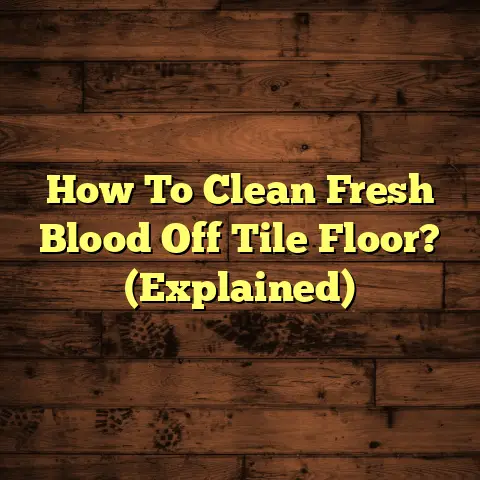Fix Cupped Floors? (1 Call Could Save Your Floor!)
And let me tell you, I’ve seen it all – from pet stains to water damage, but cupped floors?
They’re a sneaky problem that can quickly turn into a nightmare.
That’s why I’m writing this article – to help you understand, assess, and hopefully fix those cupped floors before they cause serious damage.
Let’s dive in, but first…
Safety First!
Before we even think about fixing anything, let’s talk safety.
Cupped floors aren’t just ugly; they can be downright dangerous!
Why?
-
Tripping Hazards: Those raised edges are just waiting to catch your toes.
-
Structural Issues: Cupping often means moisture, which can rot the subfloor.
-
Mold Growth: Where there’s moisture, there’s a potential for mold – a serious health concern!
So, before you start poking around, grab these:
- Knee Pads: Trust me, your knees will thank you.
- Protective Eyewear: Debris can fly when you’re working on floors.
- Gloves: Protect your hands from splinters and chemicals.
And this is crucial: if you’re not comfortable with DIY, don’t do it!
Call a professional. Seriously. It’s better to be safe than sorry.
Okay, safety briefing over. Let’s get to the nitty-gritty.
Section 1: Understanding Cupped Floors
1. Definition of Cupped Floors
What exactly are cupped floors?
Imagine a plank of wood.
Normally, it’s flat, right?
With cupping, the edges of the plank are higher than the center, creating a concave shape – like a shallow dish or, well, a cup.
You’ll usually see this in:
- Hardwood Floors: Solid hardwood is especially susceptible.
- Laminate Floors: Although less prone, laminate can cup if exposed to moisture.
- Engineered Wood: Can also cup, but is usually more stable than solid hardwood.
Visually, it looks like the floorboards are raised along their edges.
Run your hand across the floor.
Does it feel like a series of tiny speed bumps?
That’s cupping.
2. Causes of Cupping
Now, why does this happen?
The culprit is almost always moisture.
Here’s the breakdown:
-
Moisture Exposure: This is the big one. Spills, leaks, floods – anything that gets the floor wet.
-
Humidity Levels: High humidity can cause wood to absorb moisture from the air.
- According to the EPA, ideal indoor humidity should be between 30-50%. (Source: EPA Indoor Air Quality)
-
Improper Installation: If the floor wasn’t properly acclimated before installation, it can cup later.
-
Seasonal Changes: Wood expands and contracts with temperature and humidity changes.
Think of it like a sponge.
It soaks up water and swells.
Wood does the same thing.
When the top of the plank is drier than the bottom, the bottom expands more, causing the edges to rise.
3. Signs of Cupped Floors
How do you know if you have cupped floors?
Here are the telltale signs:
-
Visual Inspection: Look for the raised edges I mentioned earlier. Pay close attention to areas near water sources (kitchens, bathrooms, etc.).
-
Sound: Walk across the floor. Do you hear creaking or squeaking? That could indicate cupping.
-
Feel: Run your hand across the floor. The “speed bump” effect is a dead giveaway.
How to differentiate cupping from other issues:
-
Crowning: This is the opposite of cupping. The center of the plank is higher than the edges. Usually caused by over-sanding.
-
Buckling: This is when the entire floor lifts off the subfloor, often due to extreme moisture.
Section 2: Assessing the Situation
Okay, you’ve identified cupped floors. Now what?
It’s time to play detective and figure out the extent of the problem.
1. Initial Inspection
Start with a thorough visual inspection. Ask yourself:
-
How widespread is the cupping? Is it just a small area, or the entire floor?
-
Where is the cupping most severe? This can help you pinpoint the source of the moisture.
-
Are there any visible signs of water damage? Stains, discoloration, or mold?
Next, check the moisture levels.
A moisture meter is your best friend here.
It measures the moisture content of the wood.
-
Ideal moisture content: For hardwood floors, aim for 6-8%. (Source: National Wood Flooring Association – NWFA)
-
High moisture content: Anything above 12% is a red flag.
Check multiple spots, especially in the most affected areas.
2. Tools and Materials Needed
Here’s a list of essential tools for your inspection:
- Moisture Meter: To measure moisture content.
- Flooring Gauge: To measure the height difference between the edges and center of the planks.
- Flashlight: To inspect dark corners and under cabinets.
- Camera: To document the damage.
- Notebook and Pen: To take notes.
3. Documenting the Damage
This is crucial, especially if you plan to file an insurance claim or hire a professional.
-
Take Photos: Capture the overall damage and close-ups of the cupped areas.
-
Write Detailed Notes: Record the location, severity, and any other relevant information.
-
Keep Records: Store all your photos, notes, and moisture readings in a safe place.
Section 3: The Risks of Ignoring Cupping
So, you’ve got cupped floors.
Big deal, right? Wrong!
Ignoring cupping can lead to a whole host of problems.
1. Potential Damage
Left unchecked, cupped floors can cause:
-
Structural Damage: Moisture can rot the subfloor, weakening the entire structure.
-
Warping and Cracking: The wood can become permanently damaged.
-
Increased Repair Costs: The longer you wait, the more expensive the repairs will be.
I’ve seen cases where homeowners ignored cupping for years, only to end up needing to replace the entire subfloor.
Trust me, that’s a bill you don’t want.
2. Health Concerns
Moisture is a breeding ground for mold.
Mold can cause:
- Allergic Reactions: Sneezing, coughing, watery eyes.
- Respiratory Problems: Asthma, bronchitis.
- Skin Irritation: Rashes, hives.
According to the CDC, mold exposure can cause a variety of health problems. (Source: CDC Mold Information)
Don’t risk your health!
3. Impact on Home Value
Cupped floors are a major turnoff for potential buyers.
They scream “neglect” and “hidden problems.”
This can significantly lower your property value and make it harder to sell your home.
A survey by the National Association of Realtors found that damaged flooring is one of the top things that deter buyers.
Section 4: DIY Fixes for Cupped Floors
Alright, let’s talk about fixing those cupped floors yourself.
But remember, DIY is only appropriate for minor cupping caused by temporary moisture issues.
1. Temporary Solutions
These are things you can do right away to help dry out the floor:
-
Dehumidifiers: These suck moisture out of the air. Run them 24/7 in the affected area.
-
Fans: Circulate air to speed up the drying process.
-
Remove Moisture Sources: Fix any leaks, spills, or plumbing issues.
2. Repair Techniques
If the cupping is minor and the moisture source is gone, the floor may eventually return to normal on its own.
But if it doesn’t, here are some DIY repair options:
-
Sanding: This involves sanding down the high edges of the planks.
- Caution: This is tricky and can easily damage the floor if you’re not careful.
- Use a drum sander or orbital sander with coarse-grit sandpaper.
- Follow up with progressively finer grits.
- Always sand with the grain.
-
Replacing Damaged Planks: This is a more involved process, but it can be effective.
- Carefully remove the damaged plank.
- Clean the area.
- Install a new plank, matching the existing floor as closely as possible.
-
Refinishing: If the cupping is widespread, you may need to refinish the entire floor.
- This involves sanding down the entire floor and applying a new finish.
- It’s a big job, but it can restore the floor to its original beauty.
Important: Always wear a dust mask and eye protection when sanding.
3. Preventative Measures
The best way to deal with cupped floors is to prevent them in the first place.
-
Monitor Humidity Levels: Use a hygrometer to track humidity.
-
Control Moisture: Fix leaks promptly and clean up spills immediately.
-
Proper Installation: Ensure your floors are properly acclimated before installation.
Section 5: When to Call a Professional
DIY is great, but sometimes you need to call in the pros.
1. Signs You Need Help
Here are some red flags that indicate it’s time to call a professional:
-
Extensive Damage: If the cupping is widespread or severe.
-
Ongoing Moisture Issues: If you can’t identify or fix the source of the moisture.
-
Mold Growth: If you see or smell mold.
-
Structural Damage: If the subfloor is rotted or damaged.
-
You’re Not Comfortable with DIY: If you’re not confident in your ability to fix the problem.
2. Choosing the Right Professional
Finding a qualified flooring professional is crucial.
Here are some tips:
-
Check Certifications: Look for certifications from organizations like the NWFA.
-
Read Reviews: See what other customers have to say.
-
Ask for References: Talk to previous clients.
-
Get Multiple Quotes: Compare prices and services.
-
Verify Insurance and Licensing: Make sure they’re properly insured and licensed.
3. What to Expect from a Professional Assessment
A professional will:
-
Thoroughly Inspect the Floor: Identify the cause and extent of the cupping.
-
Measure Moisture Levels: Use professional-grade moisture meters.
-
Provide a Detailed Report: Outline the problem and recommend solutions.
-
Offer a Cost Estimate: Give you a clear idea of the repair costs.
Section 6: The Benefits of Professional Intervention
Why hire a professional?
1. Expertise and Experience
Professionals have the knowledge and experience to diagnose the problem accurately and implement effective solutions.
They can identify hidden moisture sources and address underlying issues that you might miss.
2. Long-Term Solutions
Professionals can provide long-term solutions that will prevent the cupping from returning.
This can save you money in the long run by avoiding costly repairs down the road.
3. Warranty and Guarantees
Many professionals offer warranties or guarantees on their work.
This gives you peace of mind knowing that if something goes wrong, they’ll fix it.
Conclusion: The Cost of Inaction
Cupped floors are more than just an eyesore.
They’re a sign of underlying problems that can lead to serious damage and health risks.
Ignoring them can cost you money, time, and your health.
In many cases, one call to a professional can save you a whole lot of trouble.
Whether you choose to tackle the problem yourself or hire a pro, take action now to protect your floors and your home.
Don’t wait until it’s too late!
Thanks for reading, and happy flooring!





